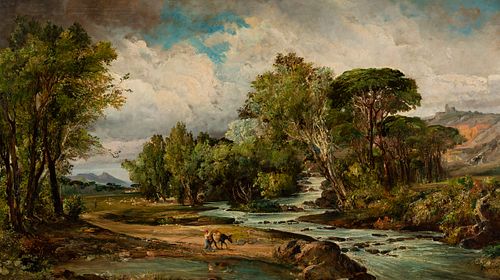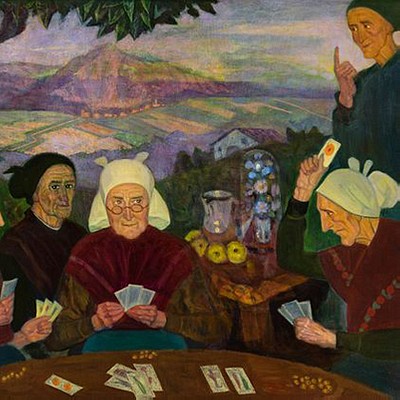RAMÓN MARTÍ ALSINA (Barcelona, 1826 - 1894). "Landscape. Oil on canvas.
Lot 83
About Seller
Setdart Auction House
Carrer Aragó 346
Barcelona
Spain
Setdart Subastas was born in 2004 and is currently the first online art auction in Spain with solidity, prestige and reliability guaranteed by our more than 60,000 users. Setdart has a young, dynamic and enterprising team ready to successfully manage the purchase and sale of art works through custom...Read more
Estimate:
EUR€12,000 - EUR€15,000
$12,500 - $15,625
Absentee vs Live bid
Two ways to bid:
- Leave a max absentee bid and the platform will bid on your behalf up to your maximum bid during the live auction.
- Bid live during the auction and your bids will be submitted real-time to the auctioneer.
Bid Increments
| Price | Bid Increment |
|---|---|
| EUR€0 | EUR€10 |
| EUR€200 | EUR€25 |
| EUR€500 | EUR€50 |
| EUR€1,000 | EUR€100 |
| EUR€3,000 | EUR€200 |
| EUR€5,000 | EUR€500 |
| EUR€10,000 | EUR€1,000 |
| EUR€20,000 | EUR€2,000 |
| EUR€50,000 | EUR€5,000 |
About Auction
By Setdart Auction House
Dec 14, 2021
Set Reminder
2021-12-14 08:00:00
2021-12-14 08:00:00
America/New_York
Bidsquare
Bidsquare : 19th & 20th Century Fine Art
https://www.bidsquare.com/auctions/setdart-auction-house/19th-20th-century-fine-art-7992
Gaudi, Sorolla, Torres Garcia, Maclet, TSUGUHARU FOUJITA, Benjamin Palencia Setdart Auction House sofia@setdart.com
Gaudi, Sorolla, Torres Garcia, Maclet, TSUGUHARU FOUJITA, Benjamin Palencia Setdart Auction House sofia@setdart.com
- Lot Description
RAMÓN MARTÍ ALSINA (Barcelona, 1826 - 1894). "Landscape. Oil on canvas. Signed in the lower right corner. Measurements: 110 x 195 cm; 121 x 200 cm (frame). In this idyllic landscape, but of realistic aesthetics, the artist presents us a scene where, in spite of the presence of the human figure, the protagonism falls on the water current. It should be noted that, during the maturity of his life, Martí Alsina constantly resorted to the representation of rivers, or streams of water, becoming a theme of his predilection. In fact, this work is very similar to the one that belongs to the collection of the Museo Carmen Thyssen in Malaga, called "El Torrente de Argentona". Considered today as the most important figure of Spanish realism, Martí Alsina is framed within the European avant-garde of the time. He revolutionized the Spanish artistic panorama of the 19th century, was a pioneer in the study of life drawing and the creator of the modern Catalan school, as well as the master of a whole generation, with disciples of the importance of Vayreda, Urgell and Torrescassana. He began his studies in Philosophy and Literature, alternating them with night classes at the School of Fine Arts in Barcelona until 1848. Once he finished this first apprenticeship and decided to take up painting, he took his first steps in the Maresme region, where he began to earn his living by painting naturalistic portraits and landscapes in "plen air". In 1852 he became a teacher of line drawing at the Escuela de la Lonja in Barcelona, and two years later he began to teach figure drawing, a post he held until the accession to the throne of Amadeo de Saboya. In 1853 he traveled to Paris, where he visited the Louvre and became familiar with the work of Horace Vernet, Eugène Delacroix and French romanticism. Later he would become acquainted with the work of Gustave Courbet, the greatest exponent of realism. In 1859 he was appointed corresponding academician of the Academy of Fine Arts of Sant Jordi in Barcelona. His first important exhibition was the General Exhibition of Fine Arts in Barcelona in 1851. From that moment on he exhibited regularly in Barcelona, Madrid and Paris, and was invited to the Universal Exposition of the French capital in 1889. Among his prizes, the medals obtained in the National Exhibitions of Madrid stand out, third in 1858 with the work "Last day of Numancia" and second in 1860 with his landscape. In his last years he lived in seclusion, focusing his efforts on the search for new forms of expression, with a brushstroke close to impressionism. Among his themes we find numerous landscapes and seascapes, urban views (especially of Barcelona), portraits and human figures, genre scenes, temperamental female nudes, history painting and biblical scenes. On few occasions he dedicated himself to still life, although he also painted some of them. Works by Martí Alsina are kept in the Prado Museum, the Thyssen-Bornemisza, the National Museum of Art of Catalonia, the MACBA, the Museum of the Abbey of Montserrat and the Museum of l'Empordà, in Figueras.
- Shipping Info
-
In-house shipping available. Please inquire at admin@setdart.com.
-
- Buyer's Premium



 EUR
EUR CAD
CAD AUD
AUD GBP
GBP MXN
MXN HKD
HKD CNY
CNY MYR
MYR SEK
SEK SGD
SGD CHF
CHF THB
THB
















